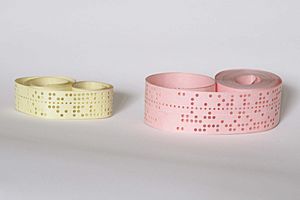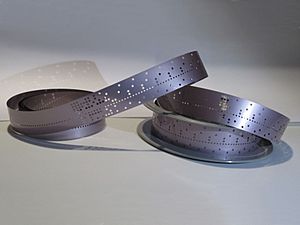Punched tape facts for kids
Punched tape is a way to store information using a long strip of paper or plastic. It has holes punched into it. These holes represent different pieces of information, just like how a computer uses ones and zeros. It's similar to a punched card, but the tape can be much longer.
Punched tape was very popular in the 1950s and 1960s. After that, newer ways of storing data took over. The idea of using punched holes to control machines started a long time ago. In the 1700s, punched tape was first used to program looms, which are machines that weave fabric. Today, some looms still use metal punched tapes to weave patterns like Tartans. You might also find punched tape in old barrel organs, which use it to play music.
In the 1900s, teleprinters also used punched tape to send messages. Herman Hollerith used punched tape for a census (counting people) in 1890. Later, in 1917, a telecommunications engineer named Gilbert Vernam created a secret code system called the Vernam cipher. This code could be used with punched tape. It worked by combining a character from the tape with a secret key to make an encoded character. If you combined the encoded character with the key again, you would get the original message back. This was a very secure way to send secret messages. The NSA has called this invention "one of the most important in the history of cryptography."
Contents
How Punched Tape Works
Punched tape comes in different styles. Today, two main types are still around that can work with the same machines.
Different Sizes of Tape
One common type of tape is about 17.4 millimeters (0.68 inches) wide. It has five places where holes can be punched. It also has a special row of smaller holes in the middle. These smaller holes are always punched and help the machine pull the tape along. The data holes are spaced out in a square pattern, about 2.54 millimeters (0.1 inches) apart.
The other main type of tape is used more often with computers. It's wider, about 25.4 millimeters (1 inch) across. This tape has eight places for holes. Like the other type, it also has a row of smaller feeding holes in the middle. Both types of tape can store ten rows of data (or characters) in about 25.4 millimeters (1 inch) of tape length. If you put a 5-hole tape on top of an 8-hole tape, the first five holes (and the feeding row) line up perfectly. This means a machine that can read 8-hole tape can also read 5-hole tape. Some machines can even create both types of tape.
How Many Characters Can Tape Hold?
An 8-hole tape can store up to 256 different characters or commands. A 5-hole tape can normally only hold 32 different characters. However, a special code called the Baudot code uses two special characters to switch between different sets of characters. This allows a 5-hole tape to encode up to 59 different characters.
Why Was Punched Tape Used?
Punched tape had some good points that made it useful for a long time:
Strong and Long-Lasting
Punched tape is very tough. If it's made from special paper or Mylar plastic, you can still read the holes decades later. This is better than storage methods that use magnetism, which can fade over time.
Easy to See and Fix
You can actually look at the holes on the tape and figure out what they mean if you need to. There are even special tools to fix tape if it gets torn. You could also edit the tape with scissors and glue to add or remove holes.
Safe from Magnets
Punched tape is not affected by magnetic fields. This was important in places with lots of electronic devices, where magnetic interference could mess up other types of data storage.
Good for Secrets
If punched tape was made of paper, it was easy to destroy. This was very important for keeping secret messages safe in cryptography. Some paper was even made to burn more easily for this purpose.
Why Did Punched Tape Stop Being Used?
By the end of the 1900s, punched tape was mostly replaced by newer technologies. Here are some reasons why:
Copying Problems
When people copied tape, they often had to check the new copy hole by hole to make sure it was exactly the same as the original. This took a lot of time.
Hard to Rewind
Getting the tape back to the beginning was often tricky and could cause problems. Some systems used tape folded like a fan, which could be fed backward to "rewind."
Not Much Data Space
Punched tape couldn't hold a lot of information. If you had more than a few dozen kilobytes of data, it became very difficult to manage the long strips of tape.
Images for kids
-
A paper tape reader on the Harwell computer with a small piece of 5-hole tape connected in a circle, making a program loop.
-
A paper tape, made from punched cards, being used in a Jacquard loom. The big holes on the edges are sprocket holes, which pull the tape through the loom.
-
Paper tape relay operations at the US FAA's Honolulu flight service station in 1964.
-
A 24-channel program tape for the Harvard Mark I computer from about 1944.
-
A paper tape reader on a computer numerical control (CNC) machine.
See also
 In Spanish: Cinta perforada para niños
In Spanish: Cinta perforada para niños












